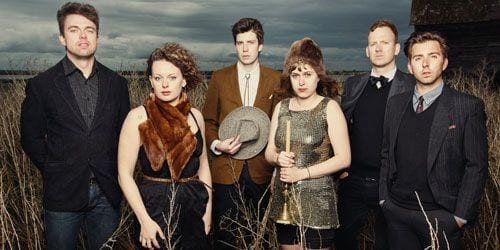
Saskatchewan, Canada band Rah Rah started in 2007 as a three-piece, but quickly doubled in size and these days they’re pushing double figures. They had some pretty good notices for their first two albums, Going Steady and 20121s Breaking Hearts, though we weren’t huge fans of Breaking Hearts here at PopMatters.
It’s both the blessing and the curse of a lot of large bands they’re known at least as much for their high-energy live shows as for their recorded output. There’s something inherently fun watching a crowd of people on stage running around madly swapping of instruments and vocal duties. But a celebratory stage show doesn’t automatically create a compelling recorded experience, and Rah Rah seem to be a bit in the ‘fun live band’ box at the moment.
Is their new album The Poet’s Dead likely to change that situation? Maybe. Certainly the album is a bit of a departure from some of their earlier material – the songwriting approach is a bit more mature, and the sound a bit fuller and cleaner than previously. On their earlier albums, Rah Rah sounded like a fun, ramshackle, slightly amateurish collective that was making songs for the hell of it, with everyone involved in most songs and the whole thing kind of lost amid a swirling wall of background keyboards, violins, and vocal shouts and singalongs.
On The Poet’s Dead the band sound more grown up, both in style and content. Here, Rah Rah seems to have really tried to focus on making the songs, and the individual lead singers on each track, stand out from the fog. It’s a strategy that’s a mixed success, which serves to highlight some distracting differences as much as it highlights the improved songs and performances. In fact, it sounds to me like the band is pulling in different directions. Now, rather than a large, messy collective of amateurs, they sound kind of like at least two different bands whose tracks have gotten jumbled together in the studio, and everyone just shrugged and released it all anyway.
For such a big band, the sound of many of the tracks on The Poet’s Dead is actually surprisingly straightforward, with the standard guitar-bass-drums combo very dominant on most tracks, and less vocal interplay than in the past. That’s especially the case on many of the tracks fronted by guitarist Marshall Burns, especially “Art and a Wife”, “The Poet’s Dead”, and “Fake Our Love”. Those tracks mostly sound like what would have been called ‘alternative rock’ back in the ’90s, especially some of the more country-flavoured bands of that era like Buffalo Tom, Cracker, and the Lemonheads. Those tracks are full of easy melodies, drawled Neil Young-inflected lead vocals, and deadpan lines. On a couple of tracks he’s even accompanied by thin, Juliana Hatfield-esque backing vocals. It’s all good fun stuff, if a little lightweight. That loose country-rock bent was present in Rah Rah’s earlier work, but wasn’t as noticeable beneath the more upbeat style and kitchen-sink approach to recording.
Those songs especially stand in contrast to the group of tracks fronted by Erin Passmore. Passmore has a broad, powerful voice with a compelling lilt that’s showcased far more on The Poet’s Dead than on the band’s previous recordings. It’s a good decision – in fact, all her songs are among the album’s highlights. The best of her songs is “Prairie Girl”, the lead single and a track where the band make full use of their dynamics. Passmore’s soaring voice, by turns bitter and wistful, dives in and out between walls of biting guitars, violins and percussion. The track has some has some nice lines too – “I am a prairie girl, straight to the bone / I’ll cut you off on the drive back home / Spend my winters alone” is strangely evocative, while “I can’t tell if you’re dumb or really smart / You’re just much happier in the dark” is delivered with real bite. The slow-burning “I’m a Killer” and album closer “Saint” are also strong songs, even if they don’t pack quite the wallop of “Prairie Girl”.
On several other songs though, especially “First Kiss” and “Run”, the band sounds almost exactly like Broken Social Scene. Big heavy repetitive riffs alternating with sudden gentle passages, languid echo-y lead vocals and sighed backing vocals, thumping percussion, various instruments thrashing away in the background. They’re not bad songs as such, but it’s such an obvious reference point for a band like this that it still feels a little disappointing, and Rah Rah can only suffer in the comparison.
More than that, though, the trouble with all these different styles in the same place isn’t so much in the songs themselves, but in the sequencing over the course of an album. Burns’ more conventional, country-inflected rock tracks especially don’t sit all that easily alongside the more intense tracks, especially those fronted by Passmore.
All this constant chopping and changing between styles I found occasionally irritating and disorienting as a listening experience. The band doesn’t have either the madcap energy and inventiveness of the likes of Architecture in Helsinki or the power and control over their dynamics as Broken Social Scene or Arcade Fire needed to really pull this sort of approach off well.
There are some strong tracks here, and there is real evidence of the band developing their abilities. Certainly this is their best collection of recordings so far, with “Prairie Girl” the real standout. But the overall result is an album that ends up being, somehow, just a little less than the sum of its parts.

![Call for Papers: All Things Reconsidered [MUSIC] May-August 2024](https://www.popmatters.com/wp-content/uploads/2024/04/all-things-reconsidered-call-music-may-2024-720x380.jpg)



